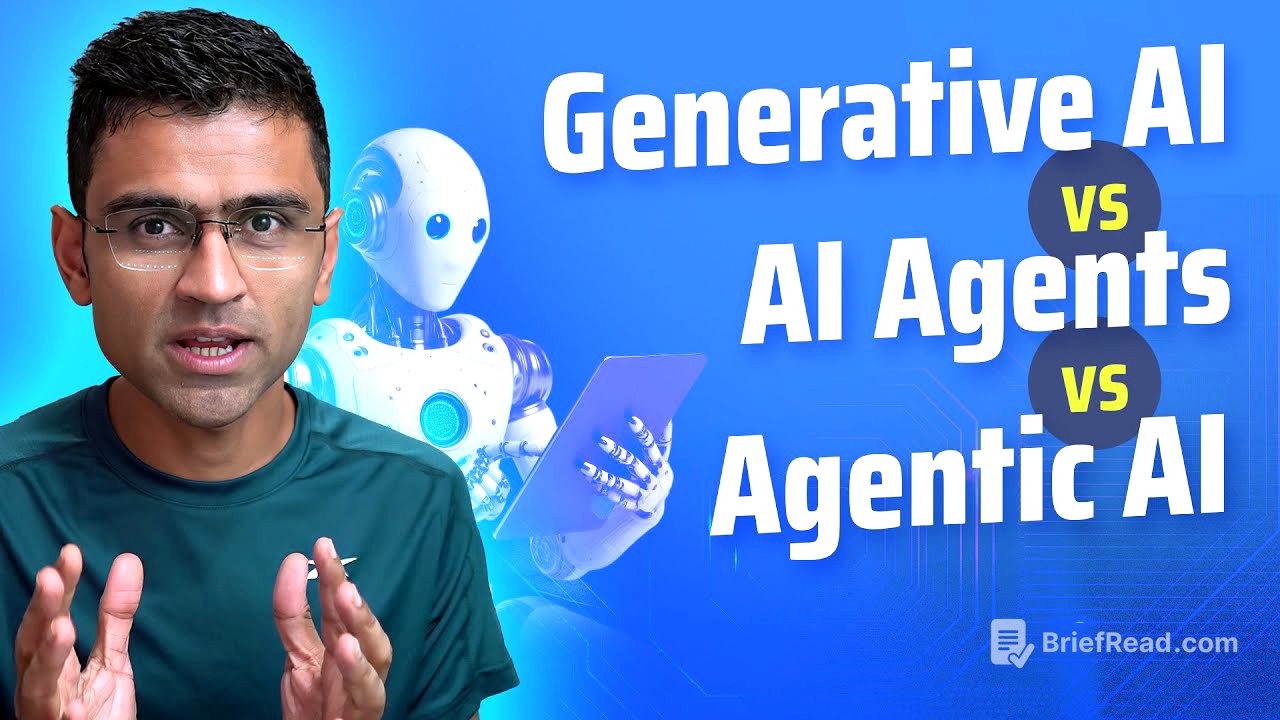TLDR;
This video explains the differences between Generative AI, AI Agents, and Agentic AI. Generative AI creates new content from existing data using large language models (LLMs). AI Agents use tools and knowledge to complete specific tasks, while Agentic AI involves multiple AI agents working together autonomously to achieve complex goals. The progression from Generative AI to AI Agent to Agentic AI represents an increase in complexity and capability, with each level building upon the previous one.
- Generative AI: Focuses on content creation (text, images, video) based on learned patterns.
- AI Agents: Utilize tools and memory to perform specific tasks, going beyond simple question answering.
- Agentic AI: Employs multiple AI agents for complex, multi-step tasks with autonomous decision-making.
Introduction to Generative AI [0:00]
Generative AI is defined as AI capable of generating new content, such as text, images, or videos, based on patterns learned from existing data. At its core is a large language model (LLM) like GPT-4 or Claude, trained on vast amounts of internet data, including Wikipedia and Google Books. While LLMs can generate answers, they have a knowledge cutoff date and cannot provide real-time information without additional tools.
AI Agents: LLMs with Tools and Knowledge [0:49]
To enhance LLMs, they can be given access to external tools and APIs, transforming them into AI Agents. For example, an LLM connected to an Expedia API can fetch real-time flight prices. These agents can perform actions, such as booking flights, by using tools, memory, and knowledge to complete tasks with some level of independent decision-making. However, these AI Agents typically handle narrow and specific tasks.
Agentic AI: Complex Systems with Multiple Agents [3:26]
Agentic AI involves more complex systems where multiple AI agents work together to achieve multi-step goals. For instance, a travel agent AI could use a weather API to plan a trip with specific weather conditions and then call an immigration AI agent to check visa eligibility before booking flights. This system demonstrates multi-step reasoning, planning, and autonomous decision-making. Control is still needed to prevent agents from being fully autonomous and accessing sensitive information.
Evolving Complexity and Capabilities [6:37]
The evolution from Generative AI with LLMs to AI Agents and then to Agentic AI signifies an increase in the complexity and sophistication of tasks that can be performed. Generative AI is limited to Q&A, AI Agents can perform simple tasks with tools and memory, and Agentic AI can handle multi-step goals with planning and coordination, often involving multiple agents. Agentic AI systems often incorporate generative AI as a core component. Frameworks like Agno are available to build these systems, and definitions can vary, but the core concept involves agents performing autonomous actions, with increasing complexity in Agentic AI.
Practical Applications and Resources [9:08]
The video references a Langraph tutorial for building AI agents and an AI boot camp project focused on onboarding new employees using Agentic AI. These resources demonstrate the practical application of these concepts in building sophisticated AI systems capable of handling complex tasks.









